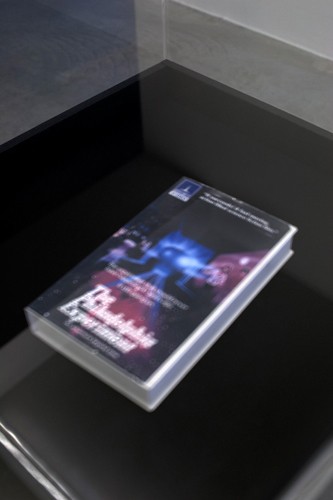
Christian Andersson, The Philadelphia Experiment (1984 VHS copy), 2005 © Christian Andersson
The 1st at Moderna: Christian Andersson
1.12 2005 – 27.12 2005
Stockholm
Pretty vacant consists of 500 ‘invisible’ nylon threads stretched diagonally across a room. The threads are set at millimetre intervals so as to form an ‘invisible’ surface on which the words “Pretty Vacant” are sprayed in fluorescent green paint. At first sight, it seems like the words have actually been sprayed into empty nothingness.
Pretty Vacant is also a well-known track by the Sex Pistols. Why is it called that?
The idea of a text painted or sprayed in the air came to me when I saw the film The Filth & The Fury and was struck by a recording of the Sex Pistols’ last concert in 1978. The band’s history ends with Johnny Rotten (Lydon) asking the audience: “Ever get the feeling you’re being cheated?” and leaving the stage. This appeals to me in lots of ways, since it seems that Lydon is asking a question that is both honest and ironic at the same time. He seems to be wondering who is cheating whom. He has realised that he has become an empty icon for a movement that was supposed to change something. He feels cheated, yet at the same time he realises that he is the one who is carrying on the lie. To me this conveyed an image of the state of desperation that someone can find themselves in when they realise that energy can never remain unfettered. It is doomed to become a rule, a truth, a concept. Even the freest of ideas falls victim to the law. It was my ideas about this fact that created pretty vacant. On the one hand, the work is a totally free thought contained in the image of an eternally hovering slogan. On the other hand, it is a methodical, almost archaeological recreation of something impulsive.
The other work in the exhibition is called Philadelphia Experiment (1984 VHS copy) and consists of a video-film case that has been put in a display cabinet. When you look at the cassette case it is blurred. Can you tell us a little about your ideas about this work?
The film is based on a well-known conspiracy theory that tells how, in 1943, the American military mistakenly made a warship disappear while attempting to make it invisible to radar. I was fascinated by the background material to the film, which is both fictive and documentary, depending on who you ask. The doubtful apprehension of truth was something I took up when I started sketching out the work. I wanted the film case to be subjected to its own contents, as though the overdramatic scenes had penetrated through the box and in the end create a situation steeped in sci-fi. In purely practical terms this consisted of my setting the video case vibrating at such a high frequency that the human eye experiences the object as being blurred. By putting the case into a state of continual disintegration, like the ship in the conspiracy theories, the work becomes a chance to actually experience the point at which an object, a concept or a truth vanishes.
We can experience your work as disrupting our conception of reality. Things that rationally cannot happen, do happen. It is as though you wanted to make viewers doubt their perceptions, to question their senses. Do you quite simply want to make viewers mind´s momentarily boggle? Or are there psychological, perhaps even political aims behind this?
I believe that perception is occasionally sidelined as a subject when, for example, psychology or politics are being discussed. What perception is actually about is how we experience the world around us, and how we then react from within those parameters. Our culture has turned into an extended empirical quest for proof, in which we believe in what has been demonstrated, while at the same time relying on what we see. In a reality as composed of images as ours is, this obviously raises questions about what ultimately can actually be called true or real. Is our history true? Is science in the form of mathematical equations real or only an assumption? Are feelings that come from dreams or other alternative states as true as gravitation? To me, there is no definitive rule for these various experiences and attitudes, and whether we like it or not we continually find ourselves thrust somewhere between the different positions. In order to protect us, our brains create an equilibrium in which we can feel safe, and this balance is often closely bound up with logic. I personally believe that it is risky to give ourselves over too frequently to logic as the only truth, as this results in a fragile grasp of reality.
Nevertheless, this is a fact that I can use in my works. They become doubt in physical form, and if I succeed, they continue to function after the viewer has exposed the bluff, or the fantastic aspect. I believe that the real effect of disrupting someone’s perception occurs when the viewer is making a feverish attempt to put their world back together again, even if it has only been out of order for a fraction of a second. So, I believe that the viewer, albeit involuntarily, is compelled to go through the components of what constitutes a reality. I believe it is here that the questions emerge about what structures, rules and spaces actually constitute our truths.
Stockholm November, 2005
Curator: Camilla Carlberg
The 1st at Moderna is an exhibition programme for contemporary art. The opening is always on the first day of the month, and the exhibitions are in different venues in or outside the museum.
